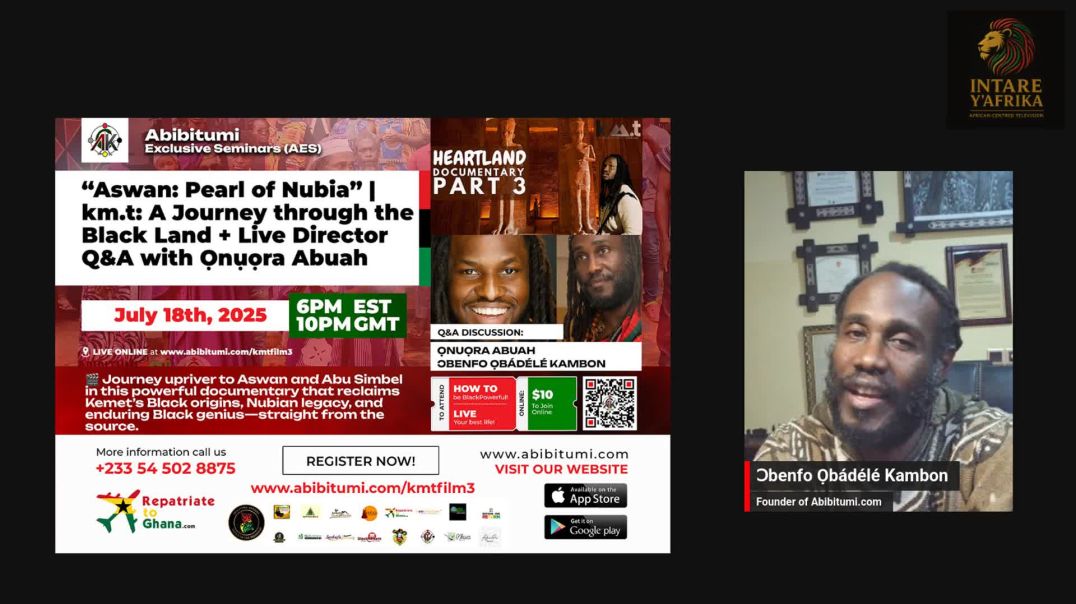- General Videos
- Music
- Economics
- Health
- Travel & Events
- History
- Psychology
- Spirituality
- Movies
- News & Politics
- Kmtyw Combat Sciences
- Ɔbenfo Ọbádélé Kambon Videos
- Ɔbenfoɔ Kamau Kambon: Black Liberation Philosophy
- Science, Tech, Engineering and Math
- Permaculture
- Self-Sustainability
- Living Off Grid
- Yoruba Language Learning
- Education
- Mmɔfra Adesua
- Nana Kamau Kambon Playlist
- Livestream
- Komplementarity Kouples and Revolutionary Singles
- Abibitumi Film Series
- Decade of Our Repatriation
- Live
Ancient African Spirituality/Religions are MIND BLOWING | 4K DOCUMENTARY
2nd Channel:
https://www.youtube.com/@LateNiteGnosis
Follow me on Twitter:
https://twitter.com/NealSendlak1
Discord:
https://discord.com/invite/uWBZkxd4UX
Lucy, the discovery of this 3.2 million-year-old fossil skeleton was such a monumental
breakthrough and what it meant for our understanding of human evolution.
In 1974, a team of researchers led by the renowned paleoanthropologist Dr.
Donald Johanson made a groundbreaking find in the Afar region of Hadar,
Ethiopia. They unearthed an almost complete fossil skeleton belonging to an early
human ancestor of our species, whom they affectionately named Lucy after the
Beatles' song "Lucy in the Sky with Diamonds."
The oldest known religion in Ethiopia is a traditional belief system called "Ethiopian
Traditional Religion" or "Ethiopian indigenous faith." This religious practice
predates the arrival of Christianity and Islam in the region by thousands of years. It encompasses a wide
range of spiritual beliefs and practices that have been passed down through
generations and are deeply rooted in Ethiopian culture and heritage.
Ethiopian Religion is characterized by its strong connection to nature,
ancestral worship, and the belief in supernatural forces and spirits. It incorporates
elements of animism, where various aspects of the natural world, such as rivers,
mountains, and trees, are considered to possess spiritual essence and are revered
accordingly.
The practice of Ethiopian Traditional Religion involves rituals, ceremonies, and
offerings to appease and seek blessings from ancestral spirits and deities. These
rituals often take place in sacred sites, such as forests, mountains, or ancient
stone structures known as "mazgabas."
The Aksumite religion, also known as the Aksumite Polytheism, refers to the
religious practices and beliefs of the Aksumite Empire, an ancient kingdom located
in present-day Ethiopia and Eritrea.
The primary deity of the Aksumite religion was the god Mahrem, also known as
Astar, who was considered the supreme god and the protector of the Aksumite
kingdom. Mahrem was associated with the sky, rain, and fertility. The Aksumite
kings, who held significant religious and political authority, were believed to be
direct descendants of Mahrem, solidifying their divine status and legitimacy.
In addition to Mahrem, the Aksumite pantheon included other gods and
goddesses, such as Astar, Beher, Meder, and Waraqa. Each deity had specific
domains and was worshipped for various purposes, including fertility, protection,
agriculture, and prosperity.
The Aksumites also practiced ancestor worship, believing that deceased ancestors
played a role in the spiritual well-being and guidance of the living. They would
honor and venerate their ancestors through rituals and offerings, seeking their
blessings and assistance.
The Aksumite religion was closely intertwined with the political and cultural
aspects of the empire. Temples and religious structures, such as the famous
Stelae of Aksum, were erected to honor the gods and commemorate the rulers.
Ritual ceremonies, sacrifices, and festivals were held to celebrate important
events, agricultural cycles, and religious observances.
With the spread of Christianity in the 4th century CE, the Aksumite religion began
to decline. Christianity eventually became the dominant religion in the region and
played a significant role in shaping Ethiopian culture and identity.
Today, remnants of the Aksumite religion can still be found in Ethiopian Orthodox
Christianity, which incorporates some elements and practices from the ancient
Aksumite belief system. However, the original Aksumite religion, as a distinct and
separate faith, ceased to exist as Christianity took root in the region. And by the 7th and 8th centuries, Islam would take over as the dominant religion of Africa. Which continues today.
The history of Africa begins with the emergence of hominids, archaic humans and — around 300,000–250,000 years ago — anatomically modern humans (Homo sapiens), in East Africa, and continues unbroken into the present as a patchwork of diverse and politically developing nation states. The earliest known recorded history arose in Ancient Egypt, and later in Nubia, the Sahel, the Maghreb, and the Horn of Africa.
Following the desertification of the Sahara, North African history became entwined with the Middle East and Southern Europe while the Bantu expansion swept from modern day Cameroon (Central West Africa) across much of the sub-Saharan continent in waves between around 1000 BC and 1 AD, creating a linguistic commonality across much of the central and Southern continent.
#gnosticinformant #documentary #africa


![PROF. BAYYINAH BELLO: My Understanding of RELIGION & SPIRITUALITY | [1997]](https://i.ytimg.com/vi/FB-jHw7UYWA/maxresdefault.jpg)

















